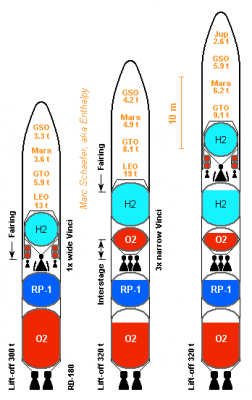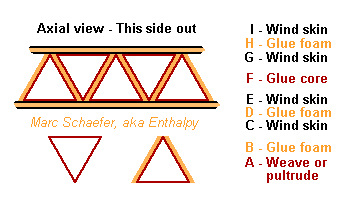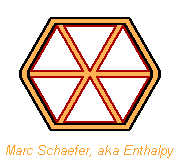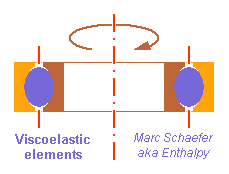-
Posts
3887 -
Joined
-
Last visited
-
Days Won
1
Content Type
Profiles
Forums
Events
Everything posted by Enthalpy
-
Methane is a more potent greenhouse gas but it doesn't accumulate in the atmosphere as carbon dioxide does. Our atmosphere full of oxygen is quite corrosive to methane. You don't really have to release carbon from the absorbed CO2. Reacting it with water to release some alcohol or hydrocarbon would be just fine and probably easier to make. More consumers could also use a liquid fuel obtained this way. To absorb atmospheric CO2, alcalis are fine, especially the cheap CaO dissolved in water. Once turned into CaCO3, it reverts to CaO by heat, say from Sunlight. You can produce a mist, like in the cooling tower of a power plant, to process much air with little power expense (try to put some figures, it's a big worry). Humidity makes air lighter, the tower then moves it for free, provided the surrounding air isn't completely saturated. Scrubbing its CO2 would also make air lighter. http://en.wikipedia.org/wiki/Cooling_tower
-
Please disable the caps lock.
-
In a molecule, atoms (usually pairs) share some electrons to make bonds. In a metal, all atoms share some electrons at the scale of the whole wire. This is what makes it metallic. These electrons already shared can move easily. (Ajb, apologies for paraphrasing...)
-
Argon is more or less affordable and non-toxic, but only 1.784kg/m3. Mix with 20% oxygen for breathing. Krypton is denser but more expensive. CO2 is nearly non-toxic over a limited time. 1562kg/m3. Mix with 20% oxygen as well. In calm air it stays separated, but will mix when people walk through, as any gas. Freons would have been nice... But all that contain chlorine atoms are forbidden, we have only the ones with fluor, and these are expensive. Depending on the effect sought, could you use artificial mist instead? Available for shows, rather dense, safe.
-
Computers from 1999 can't make any interesting amount of computations, even if you could bring 30 of them to work together properly. They must be at best late Pentium III like the one I had, and it's 20 times slower than a Core 2 which is already outfashioned. So the cheap way to make computations is to buy one used Core 2 instead and avoid the (impossible) parallel programming. Sensible uses: - Disconnect them definitely from the Internet, make only letters and the like with them. With Win95b or Win Me, NO ANTIVIRUS, and Ms Office 97, all neatly installed, a PIII is damned fast. Offer one to each family that has no computer. - Put a good recent hard disk, if needed a Sata controller card (only SiI0680 chip) on PCI (only Intel is fast), several good Ethernet cards, buy and install Win NT4 Server, use each PC as a home file server. Moderate computing capacity is enough. Even a Velociraptor on SiI0860 +Intel Pci makes sense. Again one computer per home.
-

Is there heat generation at the center of the earth?
Enthalpy replied to cosmos0's topic in Earth Science
You miss other sources of heat, especially radioactivity, estimated to contribute half as much as the initial heat last time I saw a figure. Heat is transferred by convection. Diffusion should have been too inefficient. Lighter materials make thicker hence higher continents, denser materials make thinner hence lower oceanic floor, because they're near hydrostatic equilibrium. Did you notice that oxygen is in limited amount as compared to metals and oxides are lighter, so a limited thickness of oxides floats over metals? Then you miss all the dynamic process on Earth, especially the creation of new oceanic floor and its following subduction. More generally: why make a model that ignores a century of well-established knowledge? To my eyes, it's a big effort to produce inevitably wrong results. -
I can tell for sure that a clear car window protects from Sunlight burns. I had a burn in Guyana but decided not to use a skin protection because I was in a car, and after several hours of clear weather (4° from Equator, serious there) it had not worsened a bit. Convincing synthetic experimental proof for me.
-

Speed Of Time On Mars Relative To That On Earth
Enthalpy replied to grandlear's topic in Astronomy and Cosmology
Don't forget Sun's gravitation well nor the planet's orbital speed. More important than the diurnal rotation. Orbital speed: Earth=29.8km/s Mars=24.1km/s Escape velocity: Earth=11.2km/s Mars=5.0km/s With these speeds, which also characterize the gravitation wells, you have all important contributions provided you don't mess it up... Of course, Doppler effect would exceed by far the relativistic corrections, so any experiment should correct it, say by a smart bidirectional measure. -

I or H tiles and bricks for stronger, lighter assembled structures
Enthalpy replied to Peter Dow's topic in Engineering
I don't know if this shape-lock construction can become cheaper than brick and cement. But even if it doesn't, it may have applications, for instance as a shelter against hurricanes, or as seismic-proof construction. One question if using metal or plastic: why have bricks or tiles rather than big panels? -
About the mix ratio: - KNO2 shouldn't remain in a flame where C and H are available. K2O, KOH and K2CO3 look more likely. - The flame is very hot because no nitrogen from air dilutes and cools it, so the flame produces a lot of CO in competition to CO2. More oxygen wouldn't be optimum as it would leave much CO and add unused O2. So the mix ratio shouldn't assume CO2. - You can use a rocket computation software to evaluate it, like Propep. But please don't use it in a rocket, because nitrates are too dangerous.
-

I or H tiles and bricks for stronger, lighter assembled structures
Enthalpy replied to Peter Dow's topic in Engineering
One essential condition for this shape is that the material doesn't break at the notches, that is it must be tough or resilient. A brittle material like brick or nearly any ceramic wouldn't fit, and this is a drawback, because ceramics make houses for being cheap. Because of cost, your bricks will likely be hollow. Fine: plastics can be injected, metals cast. This eases as well the production tolerances, since hollow shapes can be designed to deform more easily. Looks even more like Lego. Among plastics, polypropylene and some polyamides, as well as ABS and some kinds of PVC, are little sensitive to notches and rather affordable. Pity: all burn, some can evaporate or exsude toxic compounds, get brittle over time and especially at Sunlight... This choice needs a detailed analysis. Short glass fibres can be incorporated to injected plastics. Still affordable, makes slightly stronger but not tougher, AND can improve the flame resistance. Most metals can be cast, with zinc, aluminium, possibly magnesium being low-cost candidates. I believe injection (like plastics, well under the fusion temperature, compensate it with big pressure in a strong die) already exists for metal, allowing high production rhythm. In a variant, you could cast concrete in a hollow shape made quickly by assembling your bricks, but this exists already with hollow ceramic bricks. What about metal clamps that shrink when cooling down to ambient temperature? Shape memory alloys are too expensive, but bimetal springs look affordable. In any case, remember how fast workmen go with cement! Challenging a well-established technology is always difficult. -
To check if a medium is interesting in a thermal engine, you can compare its P*dV with the heat used in the operation. ----- In a diatomic gas, 20.79+8.31J/mol of heat (=cost) give 1K which changes PV by 8.31J/mol (=benefit, potential and overestimated). Usually the strongest candidate. Take ice: 334kJ/kg to freeze or melt it, and 8.3%*183MPa=15kJ/kg (or less than that: inferred from the liquid's bulk modulus, 2.2GPa). This ratio is far less promising than a gas, or even than a boiling liquid. For a shape memory alloy (see Wiki), this ratio would be bad also, though some people consider using them - to make electricity from the residual heat in car exhaust pipe, last time I saw it. And from a normal solid it's far worse. ----- This ratio has no theoretical significance. It puts no physical limit on the attainable efficiency. But if you consider how inefficient the technological processes are at a thermal engine, this ratio does then have a direct consequence on the achievable efficiency. No big thermal engine, where efficiency is the prime consideration, will use ice instead of vapour or a gas. But maybe a very special application, where other considerations are more important - just like for electricity from exhaust heat, a dry cycle is more important than efficiency. Could you exploit a huge amount of ice because it's available naturally and you need to add very little man-made apparatus? Similarly, we couldn't produce electricity from rain directly, but if existing mountains make the height drop and existing valleys the reservoirs, we just add a thin dam, turbines and generators, and get cheap electricity.
-
It's exactly what happens when light is faint. For instance in astronomy, or at some detectors. With good detectors and electronics we see individual photons being detected. Some pixels get a photon, others don't, over the exposure time.Those who get nothing can't say more about the source. To increase the chances to get a photon, it takes more exposure time, or a more efficient detector (if it's still not perfect), or a bigger one. Astronomers concentrate light from 10m paraboloids on one detector pixel to get sometimes a handful of photons over hours. The century-old pbservation is that faint light does randomly create a microscopic effet (move one electron for instance) or not; only the probability to act changes with light intensity. This is why the photon was introduced.
-
Some mechanisms use no spring but raise a door as it opens, letting the weight close it automatically. This make it simpler to compress the viscoelastic elements more at the end so they brake more: build them as an axial bearing, or nearly as a usual axial bearing but conical... If using a spring to close the door, a similar added movement at the viscoelastic elements can compress them at or near the end, using an oblique rod, a sliding slope... The braking action can be releaved as the door is nearly shut, to get enough speed for the strike, and avoid a permanent compression of the viscoelastic elements. Marc Schaefer, aka Enthalpy
-
Light tanks and good engines go to geosynchroneous orbit in just two stages (click the drawing to magnify). Walls are of aluminium extrusion, with a=45° and the extrusion horizontal. Magnesium would improve. At the one-Vinci stage, the long engine shall weigh 400kg, adapters 200kg, avionics 200kg, and the supported balloon tanks 40kg per ton of propellants. Notice the fairing covers them. The roll and injection verniers get hydrogen and oxygen at 1.5b from the tanks, burn them at 1.0b and expand to D=0.3m to achieve 4*500N and 376s, losing no efficiency and adding just 20kg. Nearly the ones from DLR. The empty stage carries 21.5t of propellants and weighs 1680kg. Maybe an ESC-B. ---------- At the three-Vinci stage, the short engine shall weigh 300kg. Four or six chambers could in the future share one bigger turbopump and one set of actuators. The walls (1595kg) have B=19mm t1=t2=1.5mm of AA6005A, the dropped interstage (727kg) as well. Hydrogen heads (195kg) are 1mm AA7022 ellipsoids with 2r=3.6m. The oxygen tank (205kg) is an ellipsoid (2R=4.8m, 2r=3.4m) of AA7022, top 1mm and bottom 1.5mm. It holds at the wall by two cones (61kg) of 1mm AA7022. A truss (45kg) of AA7022 tubes holds the engines to the cone - or maybe to the walls. Foam weighs 72kg. Carbon and ultra-thin steel may save mass, but aluminium is cheap and sound. Everything can be welded here. Oxygen above hydrogen might have saved wall mass as the fairing would cover it. The supported tanks weigh 2173kg and carry 53.8t of propellants, or 40kg/t. The stage weighs 3273kg empty, or 61kg/t. ---------- At the RD-180 stage, the oxygen walls (1752kg) have t1=t2=2mm of AA6082, others (1994kg) have B=19mm t1=t2=1.5mm of AA6005A to resist 6MN*m bending plus a factor of 1.5. Heads (652kg total) are ellipsoids (2R=5.4m, 2r=3.6m), 2mm of AA7022 below the oxygen, 1.5mm elsewhere. The structural walls and tanks carry 259t and weigh 4437kg or 17kg/t. The engine (5850kg), its truss (230kg) and foam (39kg) bring the empty stage to 11.1t or 43kg/t. The fairing (3400kg) is dropped with the first stage in the performance evaluation. Aluminium extrusion that light would have needed t1=t2=1mm, so this is probably standard composite. If an RD-180 equivalent is designed, it could usefully throttle more deeply, have wider nozzles, burn Pmdeta or Farnesane, have a turbine and gas generator of molybdenum. Marc Schaefer, aka Enthalpy
-
The brake might be good for doors that close automatically (commonly by a spring). Especially if braking stronger at the end. The rotating variant looks simpler to integrate in a door. More doors: a trunk door on a car. Presently they have a nitrogen spring that compensates the weight and brakes at the same time, but it tends to leak over the years. Seen more similar doors, for instance at vacuum apparatus, that should not fall freely and have a brake for this reason. Marc Schaefer, aka Enthalpy
-
ONE message before, LAST paragraph: "The gained stiffness enables tubes much voider than a bare skin or even a simple sandwich allow."
-
"I can tell you building costs go way up and people have to be trained and cert in working with mag. I doubt you will find any welders cert. and you will need clean air welding mask I am sure by osha. You might require semiannual blood tests as well." => Up to now you can copy-paste text from the Net. By the way, this seam length would be made by a machine, just as for aluminium tanks. This should be clear to everyone who has welding experience and has already seen a full-size rocket. "I have a block of mag with a flint on it in my first aid kit. You shave some with a knife and use the flint and it goes up quit nice." => And the block does not catch fire. You can do the same with a block of iron and a grinding wheel. ==================================================== Beyond magnesium extrusion, an additional possiblity would be pultrusion. Some companies claim to include long carbon fabric in the profile pultruded through the matrix. This would make the walls stiffer, stronger and lighter than aluminium and magnesium - provided, of course, that the profile show a reliable behaviour. Assembling them into a tank wall or interstage section required generous overlap of the fabric. Or is it better to weave or pultrude the hollow profiles making a core and wind the inner and outer sheets of a hollow wall? Triangular profiles can be woven and constitute the core's zigzag, possibly with a foam layer between them. I doubt a lighter tank obtained this way makes a launcher cheaper than metal extrusion does... An extruding machine costs around 100k€ and produces easily one launcher a month; many heads in parallel can make the weld joints. Marc Schaefer, aka Enthalpy ==================================================== This is how I imagine a hollow wall of composite material if not pultruded at once but assembled, with a core of elements woven or pultruded in advance: Here the core walls can be a sandwich with foam (the skins as well), which allow them to be much thicker than a honeycomb yet strong. I've sketched one layer of prisms, but there could be more. Foam between the prisms is what prevents delamination... But tension in the outer skin, resulting from the winding process, can help. A syntactic foam is heavier but stronger than PU foam. Maybe the foam can be pultruded with the prism at once. With carbon fibre for instance, the wall must be nicely stiff. At a rocket tank, the inner skin would probably hold the pressure and the other ones give stiffness. To make a single-stage-to-orbit or an upper stage, the effort could pay. A flat panel would have skins laid of fabric or crossed monodimensional prepreg, rather than wound. Not sure how new this is... Omega stiffeners are well known, maybe the foam is new. Marc Schaefer, aka Enthalpy ==================================================== About the same assembling method can produce tubes, with a core composed of prisms made in advance, and skins wound or woven around, possibly with foam layers: The gained stiffness enables tubes much voider than a bare skin or even a simple sandwich allow. I've sketched six prisms, but more layers and other angles are possible (and more meaningful). Could be nice for the masts of a Solar sail, the external truss of a rocket with balloon tanks... Marc Schaefer, aka Enthalpy
-
Ox1111, why shouldn't you try by yourself before spreading the legend of burning magnesium? I wrote "I did try". What sort of value should have any text copied from people who didn't? For your information, iron, aluminium, titanium burn more easily than magnesium - if in powder form, just like magnesium. This has nothing to do with alloying. I had to use a blowtorch and melt the magnesium ingot before it caught fire if fed with oxygen. Without oxygen it went out spontaneously. That's fact. Ah, and flashes were made of zirconium.
-
Laser weapons exist. http://en.wikipedia.org/wiki/Boeing_YAL-1 http://www.boeing.com/defense-space/military/abl/index.html and many more. Not only to make helicopter pilots blind: as well to cut incoming missiles in half. Good luck to you if you try to propagate a plasma through the atmosphere.
-
A sketch representing an extrusion section is on page 1. Strength is needed before lift-off. Magnesium is not flammable. I tried.
-
Thanks for your interest! The extrusion comprises aluminium ribs betwen the inner and outer skins, all in one piece. These ribs conduct heat far better than the foam brought outside the tank to insulate it if the tank contains a cold propellant, so both skins will have the same temperature without additional measures. Very few tanks have been stabilised by internal pressure, the older Centaur stage being the classical example; safety of ground operations lets designers stay away from that. You don't really want your rocket to collapse when emptying a lower tank - nor even if the tank empties through a leak. Personnally, I'd accept a balloon tank only if it carries nothing but itself. Nearly all other stages have stiffening ribs (or integral stiffeners, or Isogrid) machined with great effort in the sheets that constitute the tanks, precisely to stiffen the walls and let them resist buckling. This is the aim of my extruded structure: provide stiff yet light plates for tank walls, interstages and fairings, that need less effort to produce than an isogrid or an assembled skin. Maybe magnesium alloys can be extruded? Less dense but thicker material would resist buckling better despite the lower modulus. If some alloy permits thin extrusions, this would enable even lighter tanks. Marc Schaefer, aka Enthalpy
-
- Expensive, but magnetrons exist at 2.45 GHz for ovens - Short distance, because of diffraction at 2.45 GHz - Inefficient, at best 50% - Cooks living organisms in between - Interferes with data communications To get more answers, your should describe your intent with more details. Powering a smartcard with 50mW isn't the same as powering a remote village with 100kW which isn't the same a transmitting 10GW from an orbital Solar power plant to Earth.
-
What is the size of your 4 billion integers? Whether they're on 16, 32 or 64 bits, the anwswer won't be the same!
-
I've sketched the viscoelastic elements as rings up to now, but any rotatable shape fits: ball, roller, truncated cone, gear... In the sketch below, balls are squeezed between two races to brake a rotation. Usual construction variants of bearings apply: axial, angular contact, roller... Some would let adjust the braking effect through variable compression. Standard mechanical ingeniosity shall draw parts that can be assembled. Such a rotating brake has some bearing capability which dampens vibrations. Combine with usual stiff bearings if preferred; one might even share the races among hard and viscoelastic rolling elements. The path stability of rollers, needles and cones should be thought through or experimented. Maybe these can receive an internal hard axis to guide them in a cage. If using a cage with plain elastomers, it should slip well: consider perfluoropolymers, perhaps with a shape elastic enough to accommodate the elastomer. The amount of squeezing can vary along the rotation angle if useful, for instance using oval races. Say, a dish antenna could hold on a satellite by soft damping bearings during flight, then open gently, more slowly at the end. Braking a rotation over many turns has also uses, for instance at a differential, but the capacity of the viscoelastic elements to dissipate heat should be checked. Marc Schaefer, aka Enthalpy





